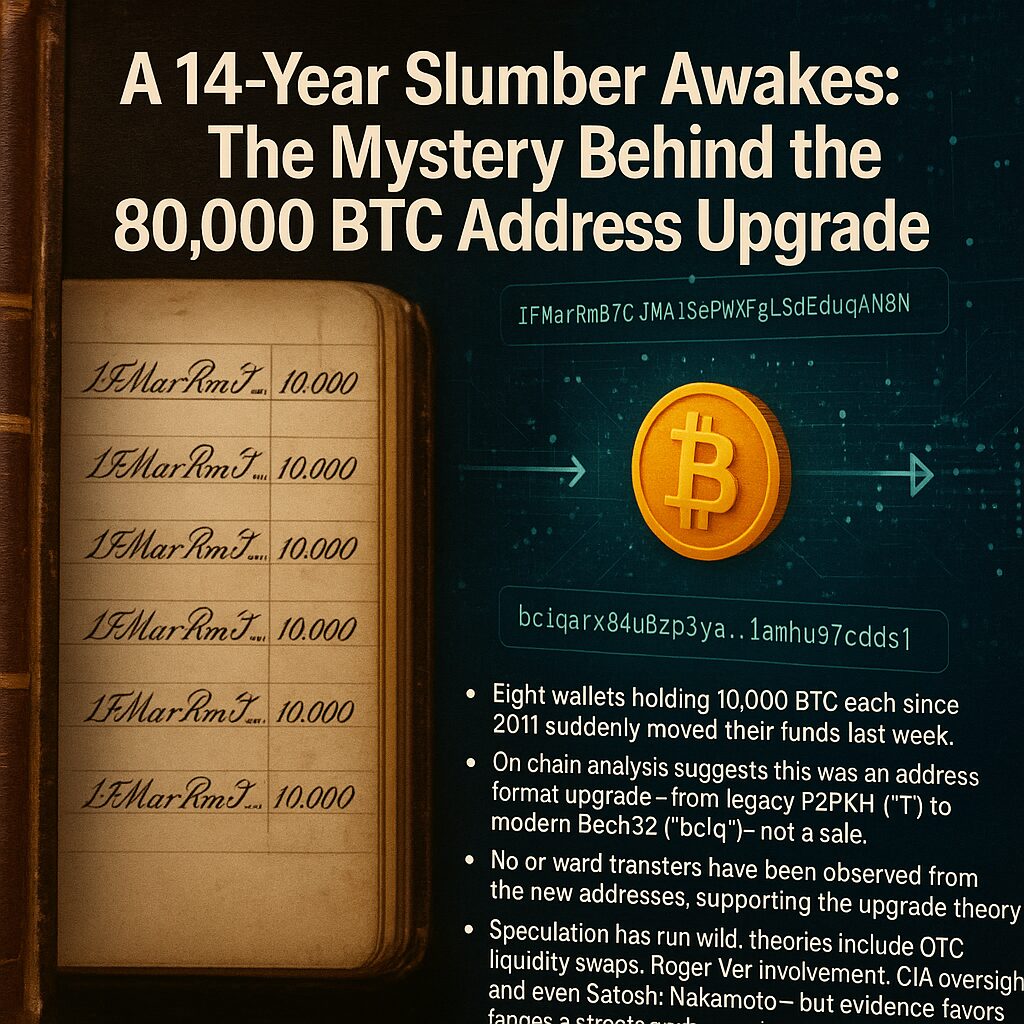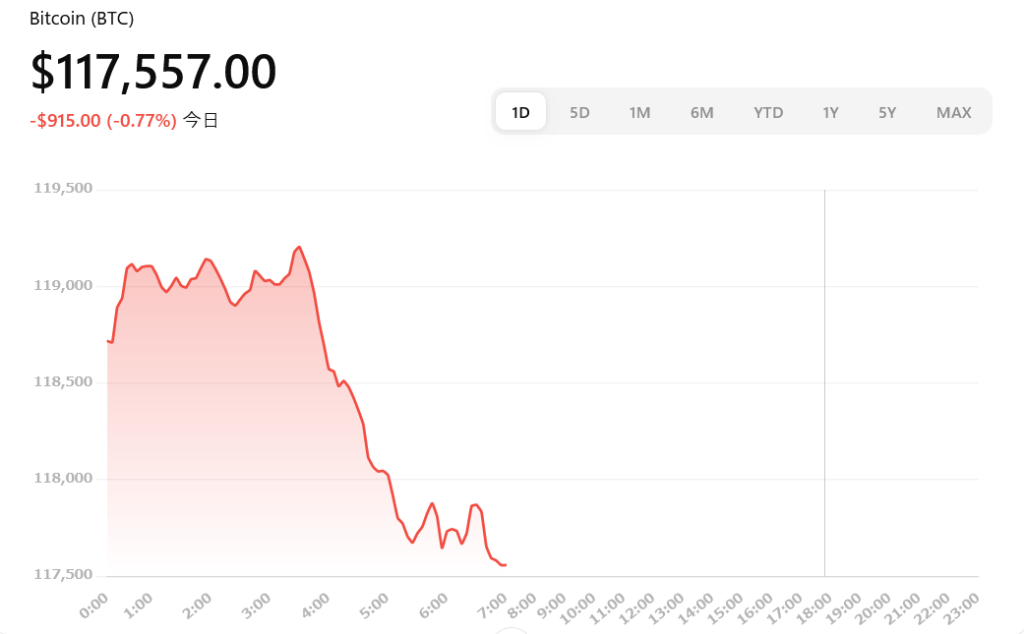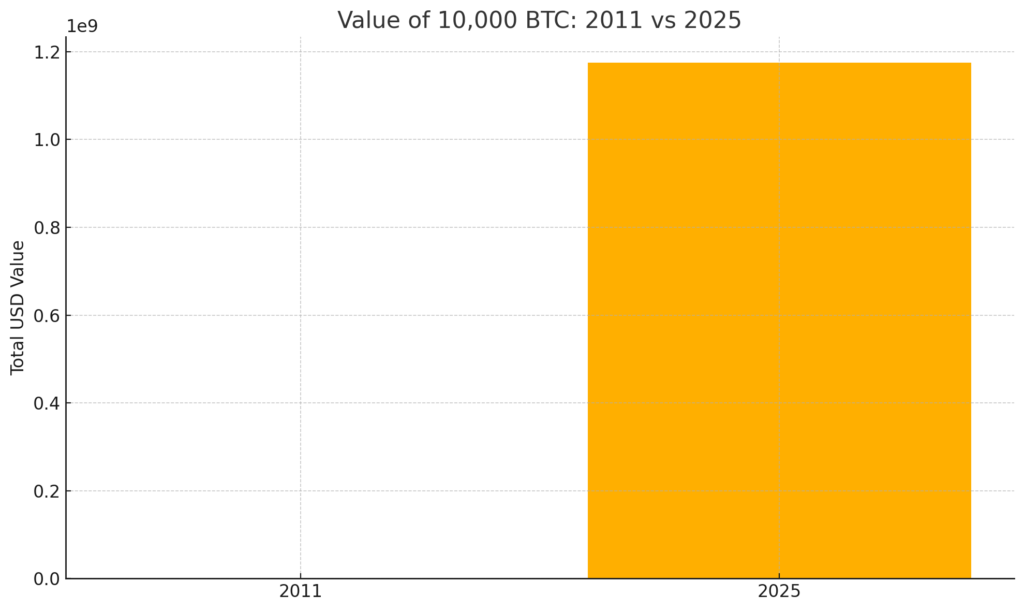
Main Points:
- Eight wallets holding 10,000 BTC each since 2011 suddenly moved their funds last week.
- On-chain analysis suggests this was an address format upgrade—from legacy P2PKH (“1”) to modern Bech32 (“bc1q”)—not a sale.
- No onward transfers have been observed from the new addresses, supporting the upgrade theory.
- Speculation has run wild: theories include OTC liquidity swaps, Roger Ver involvement, CIA oversight, and even Satoshi Nakamoto—but evidence favors a simple technical migration.
- The value growth is staggering: 10,000 BTC were worth $7,800 in April 2011 and now exceed $1.17 billion at today’s price of $117,557 per BTC (±$915 intraday)

- The move highlights both Bitcoin’s maturing infrastructure (address standards) and enduring network security, while reminding investors that old coins can re-emerge at any time.
1. Background: The Great Awakening of 80,000 BTC
Last Friday into Saturday (July 4–5, 2025), eight Bitcoin addresses—silent since April 3 and May 4, 2011—each released exactly 10,000 BTC. In total, over 80,000 BTC (now worth roughly $9.4 billion) shifted on‑chain, shocking traders and analysts alike. The initial deposits in 2011 occurred when Bitcoin traded at $0.78 per coin, making each address’s holdings worth just $7,800 at the time. This symmetrical pattern—eight addresses, each an exact 10,000 BTC—and their isolation for 14 years sparked a frenzy of theories across Crypto Twitter and beyond.
2. Technical Explanation: Address Format Upgrade
Rather than a sale, Arkham Intelligence’s on-chain analysis flags a more mundane, yet perfectly logical, reason: address modernization.
- Legacy P2PKH vs. Bech32: Early Bitcoin addresses start with “1” (P2PKH), lack SegWit support, and incur higher transaction fees.
- Bech32 Advantages: Addresses starting with “bc1q” natively support SegWit, are more efficient, and reduce fees. The transition to Bech32 also facilitates better error detection and long-term compatibility.
On July 4, each legacy address forwarded its entire balance to a freshly generated Bech32 address—yet none of these new addresses have spent any coins since. This strongly indicates a security- and fee-driven migration rather than a market exit.
3. Theories Debunked
Amid the buzz, many wild narratives emerged. Below we address the most popular and why they fall short:
a) Government Seizure
- Why Some Believed It: An “invisible” DOJ operation could quietly seize old coins.
- Why Unlikely: Federal agencies publicize major forfeitures; here, there was zero official statement.
b) Mt. Gox Redistribution
- Why Some Believed It: The long-awaited dispersal of Mt. Gox user funds could explain large transfers.
- Why Unlikely: The wallets in question show no historical link to known Gox addresses, nor have trustees indicated any undisclosed holdings.
c) Satoshi Nakamoto’s Hand
- Why Some Believed It: Could Bitcoin’s creator finally access his stash?
- Why Unlikely: Patoshi-pattern analysis shows Satoshi-mined coins occupy different UTXOs and have a distinct miningnonce signature not matching these wallets.
d) Roger Ver or OTC Deals
- Why Some Believed It: Some speculate Roger Ver (aka “Bitcoin Jesus”) held these coins and is moving them post-indictment for tax fraud. Others suggest an OTC liquidity provider is preparing to supply large sell orders.
- Why Inconclusive: No onward selling is visible yet—addresses remain untouched since the upgrade—leaving both theories unproven but technically possible.
4. Value Growth Visualization
The financial magnitude of this migration is best illustrated by comparing a single 10,000 BTC wallet’s USD value at inception versus today:
Insert Figure 1 here: Bar chart comparing total USD value of 10,000 BTC in 2011 ($7,800) vs. 2025 (~$1.175 billion).

5. Market Reaction and Price Implications
Surprisingly, despite the sheer size—over $9 billion worth of BTC—spot markets remained relatively calm. Possible reasons include:
- Upgrade-Only Perception: Once Arkham’s analysis circulated, traders realized coins weren’t being sold.
- Liquidity Buffers: Major exchanges and OTC desks hold substantial reserves, absorbing the theoretical supply shock.
- Bullish Sentiment: A fresh reminder of Bitcoin’s foundational era bolsters the narrative of time-tested resilience.
However, technical analysts remain watchful. Should even a fraction of these coins be distributed to exchanges, short-term volatility could spike.
6. Implications for Practical Bitcoin Use
For developers, custodians, and heavy users, this event underscores several takeaways:
- Regularly Update Address Protocols: Legacy addresses lack modern efficiencies; migrations safeguard funds and reduce future transaction costs.
- Monitor Dormant Holdings: Long-dormant coins can re-enter circulation, impacting supply dynamics—important for on-chain analytics and risk models.
- SegWit Adoption: Broad Bech32 adoption continues to improve network throughput and fee predictability, advancing Bitcoin’s scalability.
7. What’s Next?
- On‑Chain Surveillance: Analysts will track the new addresses for any spending activity. A sale could reverberate through markets.
- Infrastructure Audits: Custodians managing large BTC reserves may audit client holdings to ensure no outdated addresses remain exposed.
- Community Dialogue: The event sparks renewed discussion around Bitcoin’s evolutionary path—from raw early-day implementations to today’s refined standards.
Conclusion
The 14-year mobilization of 80,000 BTC was not a high‑stakes market sell-off but a testament to Bitcoin’s maturation. It highlights how technical refinements—from P2PKH to Bech32—play out at scale, even for the earliest adopters. While gurus and conspiracy theorists will continue to concoct narratives, the most likely explanation is a proactive security and efficiency upgrade of vintage wallets. For investors and practitioners, this episode is both a reminder of Bitcoin’s extraordinary value growth and a cue to maintain best practices in address management. Whether these ancient coins ultimately stay on ice or trickle into circulation remains to be seen—but the lesson is clear: in Bitcoin, even old money can wake up with a bang.

